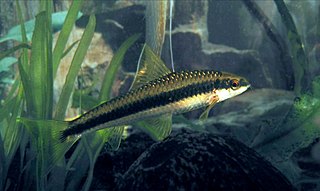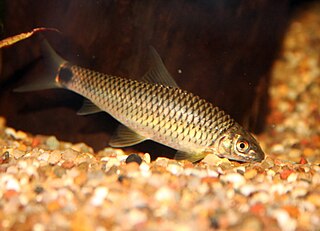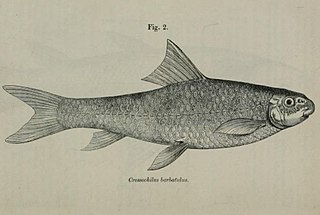
The Siamese algae-eater is a species of freshwater fish in the carp family, Cyprinidae. This bottom-dwelling tropical fish is found in mainland Southeast Asia, including the Chao Phraya and Mekong basins as well as the Malay Peninsula. Its natural habitats are streams and rivers as well as flooded forests during the rainy season. The Siamese algae-eater should not be confused with the flying fox or the false siamensis , lacking the distinctive black bands of the former.
Algae eater or algivore is a common name for any bottom-dwelling or filter-feeding aquatic animal species that specialize in feeding on algae and phytoplanktons. Algae eaters are important for the fishkeeping hobby and many are commonly kept by aquarium hobbyists to improve water quality. They are also important primary consumers that relay the biomass and energy from photosynthetic autotrophes up into the food web, as well as protecting the aquatic ecosystem against algae blooms.
Crossocheilus klatti, also known as the Isparta minnow or Anatolian golden barb, is a species of ray-finned fish in the genus Crossocheilus. It is found in the Lake Işıklı basin in the Büyük Menderes drainage in Turkey. There is some confusion regarding the identity of this fish. This poorly known species is closely related to Garra kemali, and likely should be placed in that genus.
Tylognathus is an invalid genus of ray-finned fishes in the family Cyprinidae. It was established by Heckel in 1843 without a type species. Varicorhinus diplostomus, described by Heckel in 1838 and erroneously redescribed by the same author in 1844 as T. valenciennesii, was later designated the type species. Today this fish is placed in the genus Bangana.

Labeoninae is a doubtfully distinct subfamily of ray-finned fishes in the family Cyprinidae of order Cypriniformes. They inhabit fresh water and the largest species richness is in the region around southern China, but there are also species elsewhere in Asia, and some members of Garra and Labeo are from Africa. They are a generally very apomorphic group, perhaps the most "advanced" of the Cyprinidae. A common name for these fishes is labeonins or labeoins.

Crossocheilus, also known as the fringe barbs, flying foxes, or "algae eaters", is a genus of fish in the family Cyprinidae. It is distributed in China, India, Indonesia, Malaysia and Thailand in Asia. These fish occur in several types of habitat, often fast-flowing rivers with rocky bottoms.

Gyrinocheilus is the single genus in the family Gyrinocheilidae, a family of small Southeast Asian cypriniform fishes that live in fast-flowing freshwater mountain streams. The species in this genus are commonly called algae eaters. They hold on to fixed objects using a sucker-like mouth, and, despite the name, feed on a wide range of detritus, rather than simply on algae. A "golden" variety of G. aymonieri, the Chinese algae eater or "sucking loach", can be found in many pet shops and fish farms.
Crossocheilus elegans is a fish species in the genus Crossocheilus from northern Borneo, Indonesia. Its distribution is the Segama and Kinabatangan River drainages in Sabah, Malaysia.
Crossocheilus periyarensis is a species of fish in the family Cyprinidae. This species is only found in Periyar River in Kerala, India.

Crossocheilus atrilimes is a species of freshwater fish in the family Cyprinidae. It is found in Laos, in Thailand, and in Cambodia.
Crossocheilus burmanicus, the Burmese latia, is a tropical freshwater species of fish in the family Cyprinidae, that is closely related to minnows and carps. It lives in the streams and rivers of mountains that are located in the Indian subcontinent, specifically India (Manipur) and Myanmar.

Crossocheilus reticulatus is a freshwater fish in the family Cyprinidae from Southeast Asia. It grows to 17 cm (6.7 in) standard length.
Crossocheilus obscurus is a species cyprinid fish. It occurs on Sumatra (Indonesia) and in Peninsular Malaysia. It lives in fast flowing steams with rocky substrate.

Crossocheilus cobitis is a species of ray-finned fish in the genus Crossocheilus. It is native to the Mekong basin and Indonesia and Malaysia.
Crossocheilus gnathopogon is a species of ray-finned fish in the genus Crossocheilus. It is native to Sumatra.

Crossocheilus langei, also known as the red algae eater, is a species of ray-finned fish in the genus Crossocheilus. It is native to Malaysia and Sumatra. This bottom-dwelling tropical fish is found in mainland Southeast Asia. Its natural habitats are streams and rivers as well as flooded forests during the rainy season. It is often confused with the Crossocheilus oblongus, however, both are algae eaters and will behave similarly.
Crossocheilus nigriloba is a species of ray-finned fish in the genus Crossocheilus. It is native to eastern Borneo.
Crossocheilus pseudobagroides is a species of ray-finned fish in the genus Crossocheilus. It is native to Malaysia and Indonesia.
The Antakya minnow or Orontes golden barb, is a species of ray-finned fish in the genus Garra. There is some confusion regarding the identity of this fish. Formerly thought to be extinct, when occupying the Orontes watershed in Turkey, however a synonym, Hemigrammocapoeta caudomaculata is identified as least concern by the IUCN, and is found in the Asi drainage in Turkey and Syria and Nahr al-Kabir river on the border between Syria and Lebanon, and called the Asi golden barb. They are now considered to be the same species.

Crossocheilus diplochilus is a species of ray-finned fish in the genus Crossocheilus. It is found in the Indus drainage in Pakistan, Afghanistan and India, extending into the Iranian Sistān, and coastal drainages in Pakistan.








